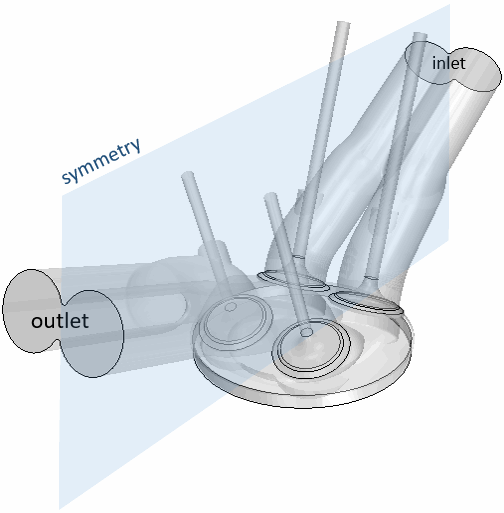Gasoline Engine: Motored
Simcenter STAR-CCM+ In-cylinder provides an automated method to perform transient moving-mesh analyses of internal combustion engines.
The purpose of this tutorial is to predict the progress of tumble and turbulence kinetic energy in a single cylinder of a motored gasoline engine until the ignition point. In general, a significant tumble inside the cylinder during the intake stroke generates high turbulence at the end of the compression stroke, which results in fast burning rates.
You simulate the intake and compression stroke in a gasoline engine that runs at 3600 RPM. The simulation starts at 300 deg crank angle. You initialize the cylinder and the ports using tabular data that describe the temperature and absolute pressure values as functions of crank angle. Simcenter STAR-CCM+ In-cylinder automatically evaluates the initial values at the respective start angle.
Air enters through the intake port inlet and exits through the exhaust port outlet, where both boundaries are modeled as pressure outlets. Similar to initialization, you specify the boundary conditions in the form of tables that describe the absolute pressure and temperature values as functions of crank angle. Air is modeled as a multi-component gas mixture of 23.31% oxygen and 76.69% nitrogen by mass.
The geometry consists of a four-valve cylinder, where the piston is in the TDC position and the valves are closed. The setup allows you to use symmetry conditions and include only half the geometry, thus reducing the computational cost of the simulation.

You model the motion of the piston and the valves:
- The piston moves in z-direction. To specify the piston motion, you set the connecting rod length to 145 mm.
- For the motion of the valves, you import tables that describe the valve lifts as functions of crank angle.
You run the simulation using automatic time-step control, which adjusts the time-step size based on preset valve lift thresholds. The simulation stops at 720 deg crank angle.
After the run, you investigate the simulation results using the post-processing capabilities that are available in Simcenter STAR-CCM+ In-cylinder.